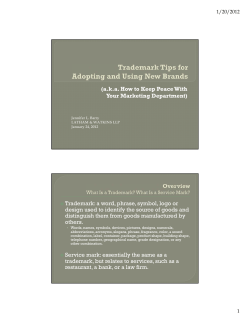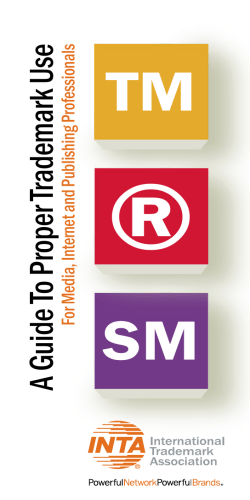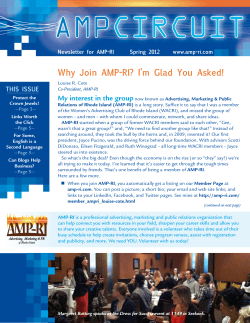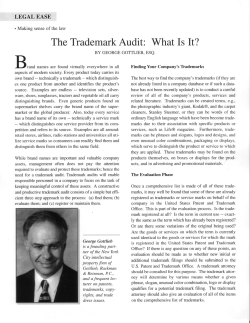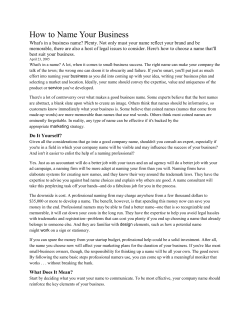
TRADEMARK ASSIGNMENT & GUIDELINES Included: Overview
TRADEMARK ASSIGNMENT & GUIDELINES Included: Overview Dos and Don’ts Checklist Trademark Assignment Instructions Sample Trademark Assignment © LEGALZOOM.COM, INC. 2008 1. Overview A company’s ability to buy and sell property is essential to its long-term life and vitality. Although it does not take up physical space, an excess of intellectual property can burden a company, directing limited funds towards maintaining registrations, defending against third-party claims, or creating and marketing a final product. Selling unused or surplus intellectual property can have an immediate positive effect on a company’s finances, generating revenue and decreasing costs. When it does come time to grow a business, companies looking to purchase property (including trademarks or software) to support their growth must be sure that the seller does, in fact, have title to the desired items. A properly-drafted trademark assignment can help in both circumstances. A trademark assignment is the transfer of an owner’s property rights in a given mark or marks. Such transfers may occur on their own or as parts of larger asset sales or purchases. Trademark assignment agreements both provide records of ownership and transfer and protect the rights of all parties. If you follow the enclosed sample and guidelines, you will have a written acknowledgment of the rights and responsibilities being transferred as part of your sale. This will provide essential documentation of ownership and liability obligations and you will be well on your way to establishing a clear record of title for all of your trademarks. 2. Dos & Don’ts Checklist A trademark protects names, terms, or symbols used to identify the products of a certain manufacturer or company. This includes brand names like “Coca-Cola” and images like Nike’s famous “swoosh.” A trademark assignment is the transfer of ownership rights in a mark from one party to another. Both the trademark and the goodwill or business associated with it must be conveyed: a transfer without goodwill is considered invalid. Keep this in mind if you revise the language of the enclosed document. An assignment is different than a license, which is a grant of permission to use a trademark in some restricted way (e.g., a limited time, specific purpose, particular area, etc.). A transfer of partial rights is not a trademark assignment: do not revise the agreement to limit the reach of the rights being provided. A trademark transfer is typically accomplished through a contract, like the written agreement form that follows. However, after the parties have negotiated and signed their agreement, the transfer must be recorded with the U.S. Patent and Trademark Office (USPTO). The agreement will not be effective if this registration is not made. The advantage of selling your trademark outright (and not simply licensing or attempting to develop and market it yourself) is that you are guaranteed payment at the price you and the purchaser have negotiated. On the other hand, that one-time payment is all that you will ever receive for your property: you will no longer have the right to control anyone else’s use of your creation. By using it yourself or offering a temporary license, you retain the potential for future income. However, such TRADEMARK ASSIGNMENT © LEGALZOOM.COM, INC. 2008 1 income is by no means certain, and your opportunities are paralleled by risk. Before selling all of your rights in a trademark, make sure that this is the best (and most lucrative) approach for you and your company. Do not enter into an agreement without completing your due diligence. If you are purchasing a trademark, conduct searches with the USPTO, all 50 states, DBA filings, other government agencies, and online directories to make sure the seller actually has complete and unique rights in the offered property. Although your findings will not guarantee title, you may have protection as an “innocent purchaser” if disputes arise. You might also find critical information about the valuation and breadth of the mark. Consider hiring a professional to help in your investigation: comparing trademarks often requires a specialized understanding of what marks will be considered confusingly similar or deceptive. If you are selling a trademark, make sure you own it. Although this may seem obvious, ownership of intellectual property is rarely clear cut. For example, you may have a name that you think of as your trademark, but unless you have used it in business you do not have rights in that mark. Even if you have been using a mark in your business, another company may have started using it before you and have priority rights in that mark. A thorough search of the relevant marketplace and registry office should be conducted before you attempt to sell your trademark. Both parties should review the assignment carefully to ensure that all relevant deal points have been included. It is better to be over-inclusive than under-inclusive. Do not assume that certain expectations or terms are agreed to if they are not stated expressly on the document. Sign two copies of the assignment, one for you and one for the other party. It’s a good idea to have your assignment notarized. This will limit later challenges to the validity of a party’s signature or of the transfer itself. If your agreement is complicated, do not use the enclosed form. Contact an attorney to help you draft an assignment that will meet your specific needs. 3. Trademark Assignment Instructions The following provision-by-provision instructions will help you understand the terms of your assignment. The numbers and letters below (e.g., Section 1, Section 2, etc.) correspond to the provisions in the agreement. Please review the entire document before starting your step-by-step process. • Introduction of Parties. Identifies the document as a trademark assignment. Write in the date on which the agreement is signed. Identify the parties and, if applicable, what type of organization(s) they are. Note that each party is given a name (e.g., “Assignor”) that will be used throughout the agreement. The Assignor is the party that is giving (“assigning”) its ownership interest and the Assignee is the party receiving it. TRADEMARK ASSIGNMENT © LEGALZOOM.COM, INC. 2008 2 • Recitals. The “whereas” clauses, referred to as recitals, define the world of the assignment and offer key background information about the parties. In this agreement, the recitals include a simple statement of the intent to transfer rights in the trademark. • Section 1: Assignment of Marks. The assignment and acceptance of the assignment of the trademarks and service marks. Note that the marks being assigned are not described in the agreement itself. The assignment references “Schedule 1,” and explains that the full description is located on that schedule. Be as complete and clear as possible in your description of the property being transferred. Note too the emphasis placed on the goodwill being sold with the property. Goodwill can be defined as the intangible value of a piece of property (e.g., a brand’s reputation and recognizability). Remember that this is an essential element of a trademark transfer: assignments attempted without goodwill are considered invalid. • Section 2: Consideration. In most agreements, each party is expected to do something. This obligation may be to perform a service, transfer ownership of property, or pay money. In this case, the Assignee is giving money (sometimes called “consideration”) to receive the Assignor’s property. Enter the amount to be paid, and indicate how long the Assignee has to make that payment after the agreement is signed. • Section 3: Assignor’s Representations and Warranties. The Assignor’s promises about the property being sold. More specifically, the Assignor is swearing that: 3(a): it is the owner. 3(b): it has not sold or transferred the marks to any third party. 3(c): it has the authority to enter the agreement. 3(d): it does not believe that the marks have been taken from any third party without authorization (e.g., a knowing copy of another company’s trademark). 3(e): it does not know of any permissions that have to be obtained in order for the assignment to be completed. In other words, once the agreement is signed, the assignment will be effective without anyone else’s input. 3(f): the marks weren’t created while the creator was employed by a third party. In many cases, if an individual was employed by a company and came up with a product, the company will own that product. This section offers assurance to the Assignee that there are no companies that will make that claim about the marks being sold. If you and the other party want to include additional representations and warranties, you can do so here. • Section 4: Assignee’s Representations and Warranties. The Assignee’s promises about the transaction. More specifically, the Assignee is swearing that it: 4(a): has the authority to enter the agreement. 4(b) has enough funds to pay for the assignment. If you and the other party want to include additional representations and warranties, you can do so here. TRADEMARK ASSIGNMENT © LEGALZOOM.COM, INC. 2008 3 • Section 5: No Early Assignment. Prevents the Assignee from re-transferring the marks, or using them as collateral for loans, until it has made complete payment of the money due under the agreement. • Section 6: Documentation. The Assignor’s promise to help with any paperwork needed to complete an assignment (e.g., filing information about the assignment with the USPTO and transferring document titles). The bracketed phrases make the additional promise that the Assignor will help with transfer paperwork for filings outside of the country. If this is not relevant to your agreement, delete the bracketed phrases. • Section 7: No Further Use of Marks. Indicates that after the effective date of the agreement, the Assignor will stop using all of the trademarks being transferred and will not challenge the Assignee’s use of those marks. • Section 8: Indemnification. A description of each party’s future obligations, if the trademark is found to infringe on a third party’s rights. There are two options provided, and you should choose the one that best fits with your situation. In the first, the Assignor takes all responsibility for infringement, promising to pay all expenses and costs relating to the claim. In the second, the Assignor makes its responsibilities conditional, greatly limiting its obligations if a claim is brought. Select only one of these options, and delete the other. • Section 9: Successors and Assigns. States that the parties’ rights and obligations will be passed on to successor organizations (if any), or organizations to which rights and obligations have been permissibly assigned. • Section 10: No Implied Waiver. Explains that even if one party allows the other to ignore break an obligation under the agreement, it does not mean that party waives any future rights to require the other to fulfill those (or any other) obligations. • Section 11: Notice. Lists the addresses to which all official or legal correspondence should be delivered. Write in a mailing address for both the Assignor and the Assignee. • Section 12: Governing Law. Allows the parties to choose the state laws that will be used to interpret the document. Note that this is not a venue provision. The included language will not impact where a potential claim can be brought. Write the applicable state law in the blank provided. • Section 13: Counterparts/Electronic Signatures. The title of this provision sounds complicated, but it is simple to explain: it says that even if the parties sign the agreement in different locations, or use electronic devices to transmit signatures (e.g., fax machines or computers), all of the separate pieces will be considered part of the same agreement. In a modern world where signing parties are often not in the same city - much less the same room - this provision ensures that business can be transacted efficiently, without sacrificing the validity of the agreement as a whole. • Section 14: Severability. Protects the terms of the agreement as a whole, even if one part is later invalidated. For example, if a state law is passed prohibiting choice-of-law clauses, it will not undo the entire agreement. Instead, only the section dealing with choice of law would be invalidated, leaving the remainder of the assignment enforceable. TRADEMARK ASSIGNMENT © LEGALZOOM.COM, INC. 2008 4 • Section 15: Entire Agreement. The parties’ agreement that the document they’re signing is “the agreement” about the issues involved. Unfortunately, the inclusion of this provision will not prevent a party from arguing that other enforceable promises exist, but it will provide you some protection from these claims. • Section 16: Headings. Notes that the headings at the beginning of each section are meant to organize the document, and should not be considered operational parts of the note. • Schedule 1: List of Trademarks and/or Service Marks. In order for a trademark assignment to be effective, the marks being transferred must be clearly identified. Be thorough in your description and attach any registrations or samples that you may have. If you do include samples, reference the inclusion of those samples in the schedule (e.g., “* See attached drawing”). DISCLAIMER LegalZoom is not a law firm. The information contained in the packet is general legal information and should not be construed as legal advice to be applied to any specific factual situation. The use of the materials in this packet does not create or constitute an attorney-client relationship between the user of this form and LegalZoom, its employees or any other person associated with LegalZoom. Because the law differs in each legal jurisdiction and may be interpreted or applied differently depending on your location or situation, you should not rely upon the materials provided in this packet without first consulting an attorney with respect to your specific situation. The materials in this packet are provided "As-Is," without warranty or condition of any kind whatsoever. LegalZoom does not warrant the materials' quality, accuracy, timeliness, completeness, merchantability or fitness for use or purpose. To the maximum extent provided by law, LegalZoom, it agents and officers shall not be liable for any damages whatsoever (including compensatory, special, direct, incidental, indirect, consequential, punitive or any other damages) arising out of the use or the inability to use the materials provided in this packet. TRADEMARK ASSIGNMENT © LEGALZOOM.COM, INC. 2008 5 Form Sample TRADEMARK ASSIGNMENT © LEGALZOOM.COM, INC. 2008 6
© Copyright 2026
